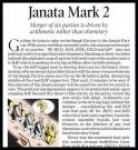Janata Mark 2? Ho hum
What can you say about the new Janata combine? Not a lot. And that's what the editorials did, as
DARIUS NAKHOONWALA discovered. Pix: the ToI edit on April 16, 2015.

You don’t say!
Darius Nakhoonwala
The formation of a Janata party, Version n, where n can mean any number you choose for it, had the editorial writers at their pensive and ruminative best. With furrowed brows and in low voices, they asked all the right questions.
Most were pessimistic. Many were sneered. None pointed out that in our electoral system, it is better to be united than divided. This, despite what Mr Mulayam Singh Yadav, whom the new Janata party has chosen as its Bhishma, had said, namely, that whenever the non-Congress, non-BJP parties unite, they end up forming the government in Delhi as in 1977, 1989, 1996.
Delhi may be four years away, but Bihar looms large on the horizon. The new Janata has only that election in mind.
Ignoring this, the Indian Express focused on the negatives as if a general election was a year away. “Another reunion of the Janata Parivar has been announced but its leading lights may still not have fully come to terms with political change.”
After listing out the elements of these changes, the paper sighed gloomily that “the Janata combine may or may not be successful in halting the BJP’s advance” and asked whether “the comfort of numbers avert the need for each of them to confront the incoherencies and failures that have led to their relative relegation. In the noise of coming together, will the individual moments of reckoning again go unheeded?”
The Hindu was mildly positive. It called it “a political development of some significance” because “this formation will pose a challenge to the BJP in those very States from where the party won a bulk of its Lok Sabha seats: Uttar Pradesh and Bihar.” It also pointed out the clout this formation has in parliament, namely, “in the Rajya Sabha it will be the third largest party with 30 MPs, behind only the Congress and the BJP.” In the current context, that is real power. The edit should have stopped there but how do you fill a 500 word space?
The Times of India called it a “significant development…this alphabet soup of parties will seek to provide an alternative to the BJP, which is seeking to win big in Bihar after its Delhi debacle.” Yes, that’s it. Stop. Instead the edit went on for another 300 words and added no value.
The Hindustan Times didn’t do much better. It said “It has been by now well-established that some of these parties have caste as their fulcrum and the rivalries between them are essentially caste rivalries…The first test of this alliance is the upcoming Bihar election…the new outfit will be compelled to do business with the Congress, the only party that has adhered to (the secular) ideal all along.”
The Pioneer, a supporter of the BJP, tried to sound principled, brave and confident. “The merger has nothing to do with principles or ethics - and certainly not with socialism. The six parties realised that individually they were ill-equipped to take on the BJP. They now hope to do so jointly…the BJP has dismissed the home-coming as ‘zero plus zero adding up to zero’…the real test for all concerned will be the Bihar Assembly election.” It then went on to point out, in wearying detail, how the new formation would fail the test.
It did point out, though, that “the outcome can also impact the future of the nascent party in neighbouring Uttar Pradesh, where an Assembly election is due in a couple of years’ time. All in all, interesting political times are ahead.” True.
The Economic Times was the only business paper to write an edit on the new party. But most of the wordage in the 294-word edit was taken up by listing the names of the six parties that have come together, and their leaders. “The combine could find space across a huge swathe of India based on caste appeal. But is that enough?”
It answered itself: No. A more pointless edit I have rarely seen.
Such articles are only possible because of your support. Help the Hoot. The Hoot is an independent initiative of the Media Foundation and requires funds for independent media monitoring. Please support us. Every rupee helps.
Subscribe To The Newsletter






